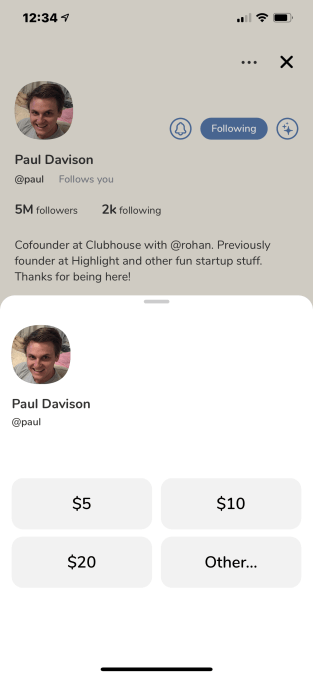Clubhouse is rapidly expanding access to payments, its first revenue-generating feature for creators, since its launch into testing earlier this month. At the beginning of April, Clubhouse said it would give a “small test group” of creators the ability to accept payments from their fans and supporters through the social audio app. These donations go 100% to the creators, Clubhouse noted at the time. Though tests began with just 1,000 users, Clubhouse this weekend rolled out payments to another 60,000-plus users in the U.S., the company said during its Town Hall weekly event. And it expects to have payments roll out to everyone over the next few weeks.
That’s a fast pace of development for an app that’s now being challenged on all sides from companies including Twitter, Facebook, Spotify, Reddit, Discord and even LinkedIn. By making payments more quickly available, Clubhouse could potentially better retain its top creators who could otherwise be influenced to jump ship for a rival app with a broader reach.
During Clubhouse’s Town Hall event, co-founder Paul Davison noted that another 66,000 creators gained the ability to receive payments this weekend, following the launch of the original test. To send a payment, users can visit a creator’s profile, then tap on the button at the bottom that says “Send Money.” This will launch a screen that suggests amounts like $5, $10 or $20, or you can fill in your own amount. The feature is being powered by Stripe and currently requires a debit or credit card to work.

Image Credits: Clubhouse screenshot
Davison again noted that creators will receive the full amount users send, while the fees paid on transactions will go to its partner Stripe to cover the payment processing fees. He added, too, that users should not send Clubhouse team members like himself payments, even though their profiles include the feature. Though he didn’t say why — only noting that all such donations would be given to charity — the reason has to do with how in-app purchases work on the App Store.
Apple a couple of years ago carved out an exception to its rules around commissions on in-app purchases in those cases where the business wasn’t profiting in any way from the donations or tips being sent to creators using the app. That’s why Clubhouse has stressed that it doesn’t take a cut of creator revenue at this time and why it’s emphasizing that it doesn’t keep any donations sent its way, either.
The company also cleared up some rumors around who would first gain access to payments, noting that users didn’t have a start a “club” on Clubhouse in order to be considered. Instead, Davison said the app was prioritizing those users who had been recently active and who didn’t have any violations. But otherwise, the initial testers have been a largely random sampling.
In-app payments are only one of the avenues Clubhouse plans to explore to generate revenue both for creators and, longer-term, for itself. The company is also considering features like subscriptions for creators and clubs, ticketed events and brand deals.
Clubhouse also offered an update on plans for its Creator First program. The company last month announced the program, which will help creators get their first shows off the ground with Clubhouse’s help. Selected creators will receive equipment, get promotional and marketing support, and receive help with booking guests and even income.
To date, Clubhouse has fielded over 5,000 submissions from interested users. To narrow down the field, the company said it will host a “pilot season” of sorts beginning April 23, where 60 yet-to-be-announced creators will debut shows at a pace of one episode over a three-week period. The Creator First program participants will then be selected based on feedback from a panel of judges and the Clubhouse community. Those initial 60 finalists will be announced April 23, the company said.














